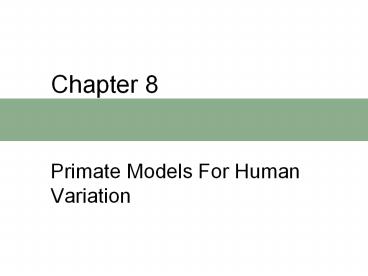Primate%20Models%20For%20Human%20Variation - PowerPoint PPT Presentation
Title:
Primate%20Models%20For%20Human%20Variation
Description:
Vervet monkeys have three different vocalizations to indicate types of predators. ... yet we cage nonhuman primates with little regard for their needs. – PowerPoint PPT presentation
Number of Views:81
Avg rating:3.0/5.0
Title: Primate%20Models%20For%20Human%20Variation
1
Chapter 8
- Primate Models For Human Variation
2
Chapter Outline
- Human Origins and Behavior
- Brain and Body Size
- Language
- Primate Cultural Behavior
- Aggressive Interactions Between Groups
- Affiliation, Altruism, and Cooperation
- The Primate Continuum
3
Human Origins and Behavior
- Humans and chimpanzees share more than 98 of
their DNA, yet contrast in aspects of anatomy and
behavior. - Behavioral and anatomical adaptations were
selected for as early hominids spent more time on
the ground and exploited different food resources.
4
Brain and Body Size
- The relationship between body and brain size is
expressed as the index of encephalization. - Most primates have brain sizes close to their
expected values given their body sizes. - Modern humans have a brain size much larger than
expected for their body weight. - Early members of the genus Homo, as well as
Australopithecines were not as encephalized as
modern humans.
5
Brain Growth and Development
- In nonhuman primates, the most rapid period of
brain development occurs either before or
immediately after birth. - In humans, brain growth occurs before and after
birth, resulting in greater brain expansion
during the first year after birth.
6
Developmental Changes in the Skulls of
Chimpanzees and Humans
7
Primate Language Abilities
- Social interactions and problem-solving abilities
demonstrate primate intelligence. - Vervet monkeys have three different vocalizations
to indicate types of predators. - The fact that apes cant speak has more to do
with their anatomy and the language related
structures of the brain than intelligence.
8
Development of Language Abilities
- Ape language experiments suggest that the
earliest hominids must have had ape-like
communicative abilities. - We dont understand why communication became
increasingly important in the hominid lineage,
and why natural selection acted to enhance our
ancestors ability to use spoken language.
9
Evolution of Human Language
10
Criteria for Cultural Acts in Other Species
Innovation New pattern is invented or modified.
Dissemination Pattern is acquired (through imitation) by another from an innovator.
Innovation New pattern is invented or modified.
Dissemination Pattern is acquired (through imitation) by another from an innovator.
11
Criteria for Cultural Acts in Other Species
Diffusion Pattern spreads from one group to another.
Tradition Pattern persists from innovators generation to the next.
Nonsubsistence Pattern transcends subsistence.
Naturalness Pattern is shown in absence of direct human influence.
12
Nonhuman Primate Cultural Behavior
- Cultural behavior is learned and passed from one
generation to the next. - Chimpanzee culture includes tools such as termite
fishing sticks and leaf sponges.
13
Aggression
- Primates might defend a core area within their
permanent home. - Jane Goodall witnessed unprovoked, brutal attacks
of chimpanzees by other chimpanzees. - Territoriality and acquisition of females are the
motives suggested for chimpanzee male aggression.
14
Altruism
- Altruistic behaviors benefit another while
involving some risk to the performer - The majority of altruistic acts consist of the
mother protecting her offspring. - Primates deviate somewhat from this pattern in
that the recipient and the performer of the
altruistic acts may not be closely related to
each other.
15
Cooperative Behaviors
- Include alliances, coalitions, and grooming
partnerships. - Chimpanzees form alliances to increase their
status or to gain protection from others. - Chimpanzees frequently cooperate with each other
in hunts. - The patterns of cooperation in chimpanzee hunting
behavior may provide clues to the development of
human hunting behavior.
16
The Primate Continuum
- Human brains are larger than primate brains, but
the neurological processes are functionally the
same. - That humans are part of an evolutionary continuum
is the basis for animal research, yet we cage
nonhuman primates with little regard for their
needs. - Nonhuman primates should be maintained in social
groups and introduced to habitat enrichment
programs.
17
Primate Behavioral Models for Human Evolution































